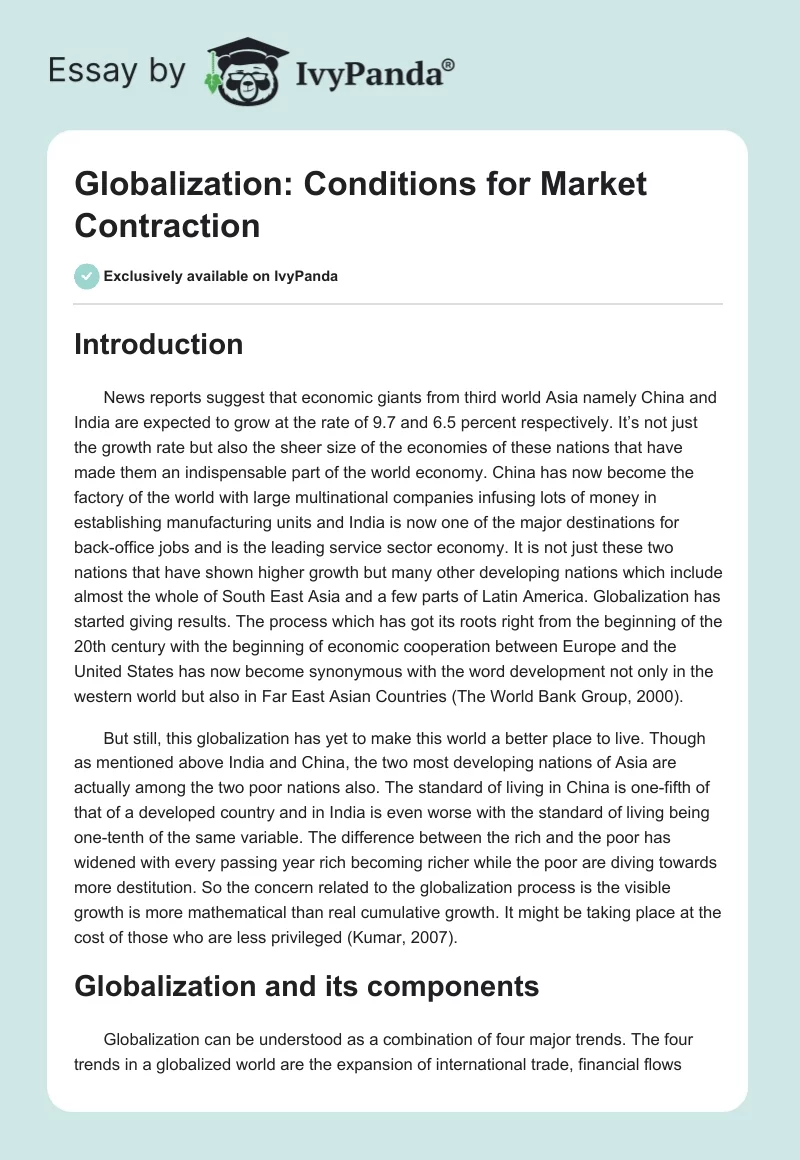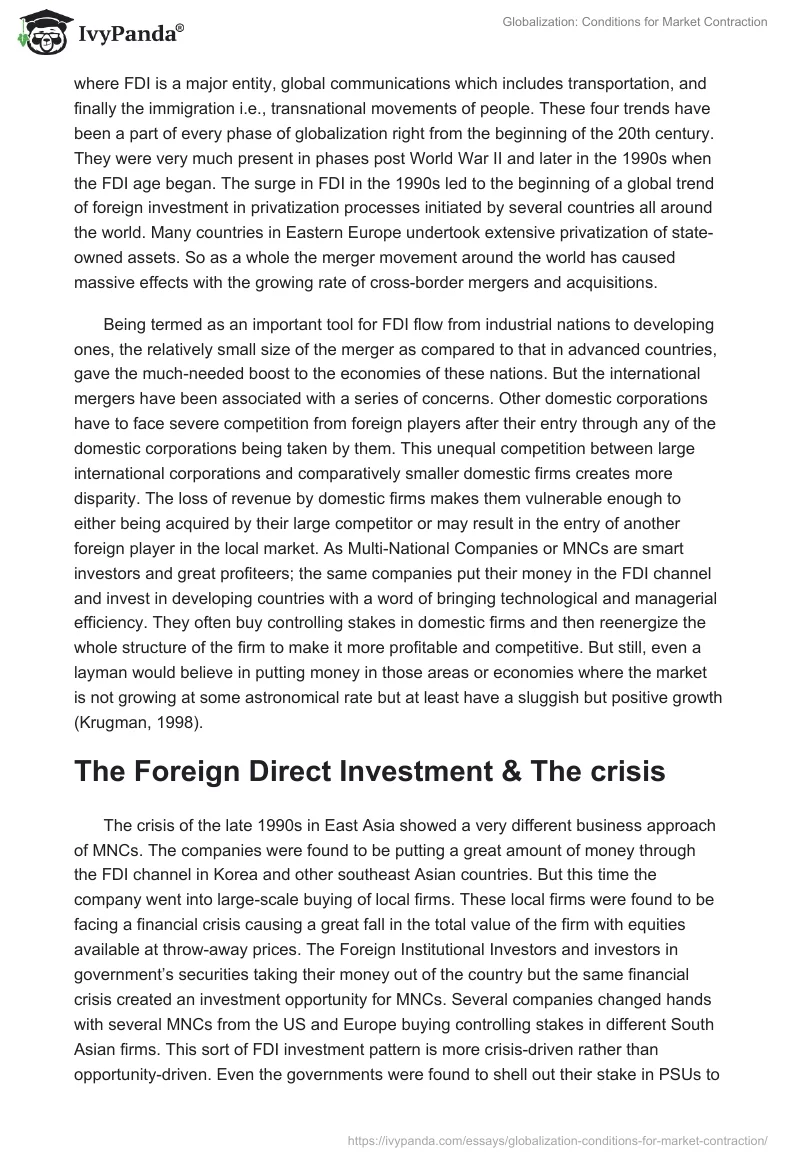Introduction
News reports suggest that economic giants from third world Asia namely China and India are expected to grow at the rate of 9.7 and 6.5 percent respectively. It’s not just the growth rate but also the sheer size of the economies of these nations that have made them an indispensable part of the world economy. China has now become the factory of the world with large multinational companies infusing lots of money in establishing manufacturing units and India is now one of the major destinations for back-office jobs and is the leading service sector economy. It is not just these two nations that have shown higher growth but many other developing nations which include almost the whole of South East Asia and a few parts of Latin America. Globalization has started giving results. The process which has got its roots right from the beginning of the 20th century with the beginning of economic cooperation between Europe and the United States has now become synonymous with the word development not only in the western world but also in Far East Asian Countries (The World Bank Group, 2000).
But still, this globalization has yet to make this world a better place to live. Though as mentioned above India and China, the two most developing nations of Asia are actually among the two poor nations also. The standard of living in China is one-fifth of that of a developed country and in India is even worse with the standard of living being one-tenth of the same variable. The difference between the rich and the poor has widened with every passing year rich becoming richer while the poor are diving towards more destitution. So the concern related to the globalization process is the visible growth is more mathematical than real cumulative growth. It might be taking place at the cost of those who are less privileged (Kumar, 2007).
Globalization and its components
Globalization can be understood as a combination of four major trends. The four trends in a globalized world are the expansion of international trade, financial flows where FDI is a major entity, global communications which includes transportation, and finally the immigration i.e., transnational movements of people. These four trends have been a part of every phase of globalization right from the beginning of the 20th century. They were very much present in phases post World War II and later in the 1990s when the FDI age began. The surge in FDI in the 1990s led to the beginning of a global trend of foreign investment in privatization processes initiated by several countries all around the world. Many countries in Eastern Europe undertook extensive privatization of state-owned assets. So as a whole the merger movement around the world has caused massive effects with the growing rate of cross-border mergers and acquisitions.
Being termed as an important tool for FDI flow from industrial nations to developing ones, the relatively small size of the merger as compared to that in advanced countries, gave the much-needed boost to the economies of these nations. But the international mergers have been associated with a series of concerns. Other domestic corporations have to face severe competition from foreign players after their entry through any of the domestic corporations being taken by them. This unequal competition between large international corporations and comparatively smaller domestic firms creates more disparity. The loss of revenue by domestic firms makes them vulnerable enough to either being acquired by their large competitor or may result in the entry of another foreign player in the local market. As Multi-National Companies or MNCs are smart investors and great profiteers; the same companies put their money in the FDI channel and invest in developing countries with a word of bringing technological and managerial efficiency. They often buy controlling stakes in domestic firms and then reenergize the whole structure of the firm to make it more profitable and competitive. But still, even a layman would believe in putting money in those areas or economies where the market is not growing at some astronomical rate but at least have a sluggish but positive growth (Krugman, 1998).
The Foreign Direct Investment & The crisis
The crisis of the late 1990s in East Asia showed a very different business approach of MNCs. The companies were found to be putting a great amount of money through the FDI channel in Korea and other southeast Asian countries. But this time the company went into large-scale buying of local firms. These local firms were found to be facing a financial crisis causing a great fall in the total value of the firm with equities available at throw-away prices. The Foreign Institutional Investors and investors in government’s securities taking their money out of the country but the same financial crisis created an investment opportunity for MNCs. Several companies changed hands with several MNCs from the US and Europe buying controlling stakes in different South Asian firms. This sort of FDI investment pattern is more crisis-driven rather than opportunity-driven. Even the governments were found to shell out their stake in PSUs to foreign investors to get over the ongoing financial crisis. The fall in the value of the currency and big debts diminishes the market cap of the domestic firms and then they are for sale on a platter at a throwaway price to foreign players.
The sudden fall in the value of the assets attracts the investors to buy those sick firms with a belief that once the crisis gets over these firms under the new management will turn out to be a golden goose (Aguiar & Gopinath, 2004). Hence, the loss of domestic firms from the local market will finally cause severe loss of competition and lead to monopolistic business policy and price inflation or the emergence of lower quality products. The MNCs have always been a very attractive destination for others to invest in. This psyche of investors can be tactically used by MNCs to crowd out a very big portion of domestic investment through large-scale borrowing in the domestic capital market thereby driving up the interest rates. This causes the exchange rate to overhaul and finally impacts the export of domestic produce. This loss in terms of export diminishes the growth of domestic firms and may cause some loss to MNCs but the access to out shore sources of finance helps them in getting over any problem but the domestic firms get wiped out (Gallaghar & Zarsky, 2006). So when all the above-stated conditions are taken into consideration, globalization could lead to cause market contraction rather than expansion in domestic investment and economic growth.
References
Aguiar, M. & Gopinath, G. (2004) Fire-Sale FDI and Liquidity Crisis, The Review of Economics & Statistics, Vol. 87, No. 3, Pages 439-452.
Gallagher, K. V., Zarsky, L. (2006). Rethinking Foreign Investment for Development, Boston University and Businesses for Social Responsibility, USA.
Krugman, P (1998). Firesale FDI, Working Paper, Massachusetts Institute of Technology.
Kumar, A. (2007). Does Foreign Direct Investment Help Emerging Economies? Insights from the Federal Reserve Bank of Dallas, vol. 2, no. 1.
The World Bank Group (2000), Assessing Globalization, Economic Policy Group and Development Economics Group.


